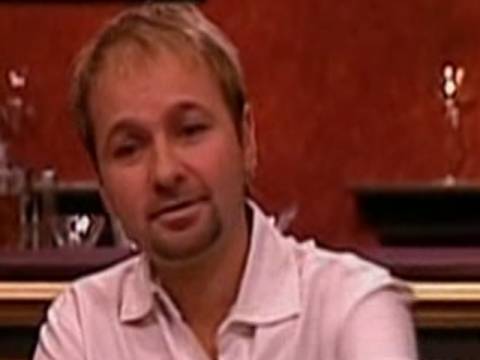The article deals with the technique of reading, thus, it may seem slightly unemotional. But it fully satisfies the interests of players who are in fact striving to improve their skills. And I would like to warn that I support those who take the assurances of the reliability of any tells with great prudence. Now, only romantic people are able to believe in this. During the years of research, I have personally encountered only two coach hints for which I could not find any contrary example until now. Maybe I'll find. The remaining hints change their meanings quite easily that is why the reading technique is a must.
They often share links to the different articles on tells with me. Friends and colleagues know that I have been dealing with issues of reading during more than one year and on a regular basis. So, I have learned that Nicolas Fradet sometimes shares his experience on "2 +2". Perhaps, it is a very modern way to present materials in, say, optimistic manner. This seems like the author avoids focusing on the fact that any hint has a hidden agenda. In one case it may mean nothing, in another one it is a sign of strength, then, a sign of weakness, etc. Thus, I disagree with his way to present the materials. Let us consider, for example, the article Disgust. Here is a snapshot taken from it:

Now, pay attention to the lips. We will reconsider them later on. A face can look in this way if a person has seen or smelled something very unappetizing. This is just one case. There is a nuance. Facial gesture displays not only emotions. We use it to express any thoughts, attitudes to the situations as well. In other words, it is a full-fledged apparatus for communication. We kind of emphasize important phrases or encourage our interlocutor by our eyebrows raised, pull grimaces, giving wordless answers. What we show is not emotions. We kind of gesticulate using "the emblems of emotions.” Let us see another picture for you again to pay attention to the activity of the lips:

The expression of despite/disgust has other twins, in addition to the emblems. It can be confused with sniffing, contained sneezing... From the above it is obvious: we should be able to separate the husk from the grain. In other words, before one confirms anything, one should determine: whether we see a hint or something unimportant, a tell or not a tell. It can be found out by just one way – by identifying a common constant. If an expression is usual for the opponent, is periodically shown during communications as a typical feature, then it is less informative and unreliable.
But let us reconsider the lips. They tend to be everted (both or only the lower lip), don’t they? You can try to make the face in front of a mirror, as if you have felt a bad smell and want to exhale: "Ough!” And then, in order to compare those expressions, sniff as if you cleanse the nose by abruptly breathing air. Then your face will look somewhat like this:
The lips are closed more tightly. Many people like Negreanu tend to have their lips rolled inside. Sniffing itself is very short in duration. Just fractions of a second. These are two very similar expressions, but the external difference is in the movements of the lips. Now, read the statement made by Nicholas Fradet for the picture of Daniel: "But there is no denying it; we can see wrinkles in the upper area of the nose and a slight raising of the upper lip: disgust.” These words surprised many people as the upper lip has not been or is lifted!
Let us suppose that Daniel is an exception to the rules and he is used to express disgust in an atypical way. Let us assume that his disgust is very similar to sniffing. But in order to say this, it is necessary to analyze more than one deal. And if we ask those who have done something of this kind they would say firmly: Negreanu got steady used to express his disgust/despite asymmetrically. Personally, I affirm this based on the analysis of hundreds of deals with his participation.
Strictly speaking, everyone may require hard evidences to be presented, as I have declared figures. It is not a problem. Those who are interested can write to me a personal message. I will provide a link to download free lessons on the basics of facial reading where the issue is easily solved. Thus, I have a lot of arguments: videos, pictures. Here, I provide one picture of Daniel’s specific manifestation of disgust/despite:

Now we can see how the left nasolabial fold rises slightly, causing the upper lip to be curved. It is so specific to this player. There is another observation. Daniel sniffs exactly in such a manner as shown in Picture 3! In other words, there are so many facts that we have to reject the idea of his disgust.
From this point of view the following piece of advice seems to be ill-judged: "So if you were sitting in Doyle’s position and happen to see that expression in Daniel’s face, you should bet for sure.” Indeed, the realities make us to recognize sniffing. Thus, we do not know yet what we can see: a tell or not a tell.
We can solve this problem by considering the video. Now, it is not worth checking out the speaker system because the sound is immediately excluded in the study of facial expressions and gestures. In addition, commentators provide with the information about the hands. And in case of training people to read facial expressions it is unacceptable. We do not know your opponents’ cards – and the full stop. Let us keep closer to the facts. Also, I have covered the hands with a black square. At 01:28 there is a slow motion replay of what Nicolas Fradet called the micro-expression of disgust. We are going to particularly focus on this fragment.
First, does sniffing relate to the common constant? No, because Negreanu does not do so in excess. He does not have the compulsive movement syndrome. The common constant is established in this context. As it turned out, not everyone is able to notice without delay that Daniel sniffs twice in a row.
Is it a tell or not? In this case it should be attributed as a hint because this "gesture" does not belong to the common constant. Moreover, he has obviously done this too often (twice per second). That is, stress exists now. As excitement can be manifested both in case of strength and weakness, we have to determine the tell: what does it evidence?
Note that we are still in a mode which I call "the healthy research ignorance” because there is little information to draw conclusions. But we do not associate our desires with the realities. We just do not know where to incline. What will help us then? We should not refer the game image for a while as Negreanu’s range often is very wide. The hand can be described as "whatever." We can add that Negreanu does not constrain himself to play only according to the opponents taking into consideration the whole alignment of forces.
A view from Canada might be of help, mightn’t it? "Doyle reaches for his chips. Obviously annoyed by the turn card, and that Doyle might have sucked out on him, Daniel shows a micro-expression… Even if we can’t usually tell for sure why a person feels a certain emotion, we can probably assume that it’s because Daniel saw something he did not like. The fact that Doyle bets into two players increases the chances he’s got a piece of the board, and that that turn card might have hurt Daniel.”
Repetition of three is unlikely to be able to have improved Brunson’s hand, who plays fairly carefully. If it could have improve someone’s position, it could be Daniel most probably – it’s he who can attack with a pre-flop from small connectors or gap connectors ... Well, the only valuable remark is that the player started to sniff when he was watching the opponent’s preparation of the attack. And we still have one of the most reliable sources of information – other tells. Why? Because it is dangerous to rely on the single hints. Along the way, we name mistakes, which we could have made as well:
1. The common constant is not determined.
2. One expression can be confused with another.
3. An expression is immediately taken for a tell.
4. An expression is immediately taken for a sign of weakness.
5. An expression is considered as an independent unit. However, hints often constitute a system where particular tells can change the meanings.
What contributes to such an approach? The example can be classified as a complex one because a number of important factors are involved. And one should be able to maneuver among them. This is the case where the risk of erroneous interpretations is high not only for beginners. We won’t hurry. The good news is that some people have already understood: tells can be compared with the alphabet. And it is better to learn to read than to look for a deeper meaning in the letters themselves.
Supplement. The article "Disgust” contains an example involving Stan Goldstein. A situation on the flop is described where a player does so, pronouncing the "check":
And once again, the statement is offered that this is disgust as the nasolabial fold has moved up, pulling the upper lip up as well. Unfortunately, if the constant is not known they rush again. The picture can be an illustration of how disgust can be expressed. But in this particular case even such brilliant researchers of facial gesture as Paul Ekman cannot affirm this definitely. Experts immediately set a range of questions. Is he a smoker? After all, smokers manifest the effect of "a lazy lip." The habit of having a cigarette in the mouth alters one’s articulation. Has he ever had a disease of the facial nerve which influenced the nature of facial movements? And so on and so on.
However, the players do not care much for the reason of such articulation. It is important whether the expression belongs to any of the constants. If it is a common constant then it is uninformative, it is not a tell. If it is a constant of strength, it is necessary to be more vigilant, more cautious. If it is a constant of weakness we can be more confident: fold equity is high, it will not stand aggression.
Note that once again I do not name Stan Goldstein’s cards deliberately. When knowing the hands it is easy to fall into a psychological trap by making instant conclusions – it is the illusion of a special knowledge that results in losses of time and money in a real game. We often can hear commentators to disapprove the players’ actions while forgetting that they judge based on their knowledge of the hands – while this information is unavailable to those who are then at the table. But now we are closer to life, we ask right questions and acquire a professional, productive thinking of a facial reader. First, it is unusual and difficult. Then a difficult task becomes easy. And an easy thing becomes beautiful.
So, I just disagreed with the contents of the article. I tried to provide reasoned arguments, because poker is initially bears risks. Players need proven information to be more successful. And trainers must protect them from mistakes. That’ll do for today. But as chance offers we will review in more detail an example of the strife between Negreanu and Brunson which is difficult for facial reading.
| 










